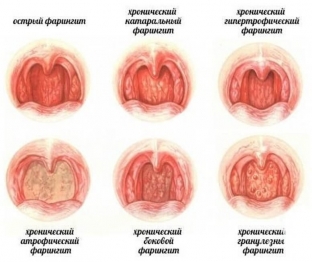Pharyngitis (from the Greek "pharyngos" – "pharynx") – This is a disease that is characterized by inflammation of the mucous membrane of the larynx and pharynx. It can develop both independently and be the result of a complication of another disease. In general, the international classification separates pharyngitis from tonsillitis, but in honey. Literature still often uses the term "tonsillopharyngitis", which more accurately conveys the nature of this disease. As a rule, pharyngitis most often occurs in men, while women have subatrophic forms of the disease. Esthet-portal.com. offers to understand the types and forms of the disease.
Classification of pharyngitis: causes and symptoms of each form
Pharyngitis has many forms and types, and therefore it is not so easy to understand them. In medicine, pharyngitis is classified according to the nature of the course of the disease as follows:
- Acute pharyngitis.
- Chronic pharyngitis.
Both types of the same disease are significantly different from each other. And, as a rule, children are the least susceptible to chronic pharyngitis, the disease is largely common in the elderly, as well as middle-aged people.

What is characteristic of acute pharyngitis
This type of disease develops quite rapidly, the manifestation of symptoms is observed almost immediately and they are pronounced: as a rule, dryness in the throat, burning sensation, pain when swallowing, perspiration, swollen lymph nodes, dry cough, stuffy ears, and often an increase temperature.
In turn, acute tonsillitis (as doctors often call pharyngitis because of the similarity of symptoms), depending on the causes that cause it, is:
- viral – the most common form of pharyngitis, the causative agent – rhinovirus;
- allergic – practically does not manifest itself on its own, it develops due to the penetration of one or another allergen into the body;
- bacterial – usually its occurrence is provoked by streptococci;
- fungal – in this case, the provocateur – fungal infection and mainly fungi of the genus Candida;
- traumatic – its occurrence initiates any damage to the pharyngeal mucosa: thermal, mechanical, chemical.
in a separate group of acute pharyngitis, those that are caused either by external factors (for example, hypothermia of the throat) or some kind of irritant (dust, caustic substances, tobacco, exhaust gases, etc.) are distinguished.
What characterizes the chronic form of pharyngitis
It can pass without an increase in temperature, while the general condition of a person is often normal. Since chronic pharyngitis develops over time, the general symptoms are somewhat smoothed out. Only from time to time can a person be disturbed by exacerbations of the disease: during these periods, symptoms of acute pharyngitis appear. In the chronic type of the disease, inflammatory neoplasms are detected, which "precipitate" throat mucosa.
Among the characteristic symptoms are: a feeling of dryness and discomfort ("coma") in the throat, copious mucous discharge, pain when swallowing, persistent cough.
Chronic pharyngitis as an independent disease occurs infrequently. Among the main reasons for its manifestation are both external factors and some features of the patient's body:
- harmful working conditions;
- irritation of the pharynx, including as a result of eating very spicy or salty foods;
- atypical structure of the respiratory or pharynx;
- immunity reduction;
- allergic reactions;
- lung, heart, and kidney health problems;
- violation of metabolic processes and the activity of the endocrine system;
- GI problems.
In turn, chronic pharyngitis is divided into:
- catarrhal – characterized by thickening and redness of the pharynx, enlarged lymph nodes;
- hypertrophic – the second phase of this form of the disease; the structure of the pharyngeal mucosa undergoes significant changes: they are accompanied by the formation of seals, nodules, inside which bacteria accumulate;
- atrophic – in this case, it becomes excessively dry and atrophies, thinning, the mucous membrane of the pharynx; this is the last and extremely severe phase of the disease.
Note that in general, the disease has a favorable prognosis. However, its chronic atrophic form requires regular symptomatic therapy.






Add a comment